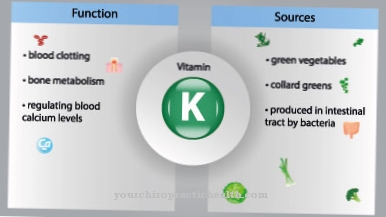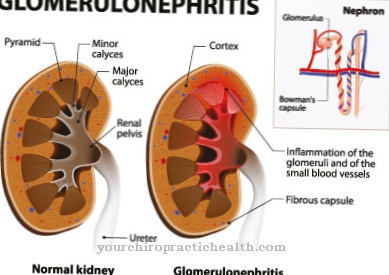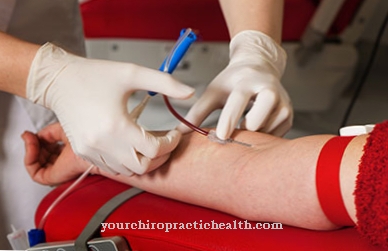There can be some skin diseases behind itchy and oozing blisters on the side surfaces of the fingers, palms and soles of the feet. One of them is Dyshidrosis, an eczema whose causes have not yet been fully explored. However, certain treatments can help by relieving the itchiness and allowing the symptoms to heal.
What is dyshidrosis?

© oscity - stock.adobe.com
Dyshidrosis is a more or less large blister on certain skin areas. They often bring reddening of the skin and are filled with the body's own substances. If the vesicles burst, there is a further risk of infection from the escaping liquid.
Most sufferers complain of severe itching, which leads to scratching the blisters, which can spread the disease. Dyshidrosis occurs in relapses and especially in warm months, which is why it was previously suspected that there was a connection with the sweat glands. This has now been refuted, but the disease still owes its name to the sweat glands.
If the disease is cured, it usually takes place through peeling of the skin. Cornea can develop, especially in the case of an intensive illness.
causes
The causes of dyshidrosis are still not fully understood. It is noticeable, however, that it occurs more frequently in people who also suffer from neurodermatitis, psoriasis or allergies. Atopic people are particularly affected, who even react allergically to contact with environmentally friendly substances.
The skin disease can also be triggered by medication, contact with heavy metals, especially nickel, chromium and cobalt salts, or massive solar radiation. Dyshidrosis could be a result of excessive skin stress, such as from alkaline soaps or cleaning products.
Other suspects are fungal infections and hereditary predispositions. While the factors listed favor the development of dyshidrosis, the onset of the skin disease due to stress is discussed.
Symptoms, ailments & signs
Dyshidrosis is primarily noticeable through the typical vesicles. These vesicles are usually only a few millimeters in size and occur in groups. Occasionally, as the disease progresses, the vesicles combine to form larger blisters. The vesicles are located under the epidermis.
They cause severe itching and pain, as well as infections and inflammation. With a slight attack, the blisters often dry out without any major discomfort. During the healing process, the skin flakes off and a callus develops. This can tear open and become inflamed if not properly treated.
In addition, the cornea is interrupted by cavities that can fill with water, pus or blood, depending on the causal disease and the location of the blisters. If the course is severe, dyshidrosis can cause other symptoms such as bleeding, eczema or even ulcers. The skin in the area of the blistering is particularly sensitive and tears quickly.
If the dyshidrosis occurs in connection with an allergy, the typical allergy symptoms usually appear. This can lead to further skin irritations and breathing difficulties, for example. The disease can be clearly diagnosed based on the typical symptoms and treated in a targeted manner.
course
Dyshidrosis is manifested by the appearance of numerous vesicles. These often only measure a small diameter of about one millimeter. If they are particularly close to one another in groups, they may combine to form larger bubbles.
The blisters are located under the epidermis, the upper skin of humans. A lower position is also possible, but this occurs rarely. In addition to severe itching and pain, infections and inflammations can also occur. However, these complications do not necessarily have to occur; with only a slight flare-up of dyshidrosis, it is also possible that the blisters dry out without further infection and the skin heals.
During the healing process, the skin dries up, flakes and forms calluses, which can later tear open. The cornea is typically interrupted by round cavities, which flake off particularly heavily as the disease progresses.
Complications
With dyshidrosis, the patient suffers from restrictions in everyday life due to the vesicles formed on the fingers and feet. These can reduce the quality of life and are often associated with unpleasant itching. However, it is advisable not to scratch the blisters, as this usually only increases the itchiness and promotes the formation of wounds.
Often the patients also suffer from pressure pain in the affected areas, so that many actions and activities are no longer possible. Movement restrictions can also occur if the dyshidrosis develops on the feet. The skin can also begin to flake.
As a rule, treatment is possible, although the underlying disease is always researched primarily. The symptoms themselves are combated with the help of creams and baths, with no further complications. Most of the time, symptoms go away in about a week.
During the healing process, the patient must protect the affected areas and must not wear gloves, for example. After the treatment there are no further difficulties. If the dyshidrosis occurs due to stomach problems, diet may be necessary. In most cases, however, the disease progresses positively.
When should you go to the doctor?
If you notice reddening, itching, or blisters on the skin, you may have dyshidrosis. Whether the symptoms require medical treatment depends primarily on the course of the underlying disease. The skin changes usually recede by themselves after a few days to weeks. If this is not the case, a visit to your family doctor or dermatologist is recommended.
Patients who suffer from neurodermatitis, psoriasis or allergies should always see a doctor. This is especially true if complications arise - for example, severe itching or infections. If the vesicles open, see a doctor immediately. Otherwise, the dyshidrosis can cause severe inflammation.
Medical examination and treatment will prevent this and provide information about the causes of the skin disease. Depending on the trigger, the doctor will then refer the patient to the appropriate specialist. If an allergy is the cause, vaccinations and preventive measures are indicated. In addition, the doctor will issue the sick person with an allergy pass for medical emergencies.
Doctors & therapists in your area
Treatment & Therapy
Not only do the causes of the disease appear to be varied, the treatment options also differ greatly from one another. First of all, research should be carried out into the cause of the disease in order to subsequently avoid it.
Otherwise, external applications such as creams or baths should help. These are often zinc shake mixtures, gelatin preparations, urea or fatty cortisone creams. During the treatment, attention is also paid to the condition of the blisters. Burning blisters and swellings can often be relieved by homeopathic remedies such as Apis mellifica C5, pus-like liquids require the use of Mezereum C4 to C5. The application should take place several times a day.
Oral treatment is also possible. This is based on the intake of the vitamin D derivative alitretinoin or cortisone. Neotigason®, which is actually intended for the treatment of psoriasis, but can also help with dyshidrosis, is also used in some cases.
If dyshidrosis occurs, care should be taken to avoid frequent disinfection of the hands. Wearing latex, rubber and PVC gloves is also a disadvantage, under which a humid climate forms, which can negatively affect the healing process.
Those affected are advised to avoid meat and dairy products if possible, or at least to reduce them significantly, which also applies to bell peppers.
In alternative medicine, acupuncture, homeopathic remedies and intestinal rehabilitation are offered, which aim to treat deeper processes that only express themselves about dyshidrosis, but see it as a symptom and not as a disease of its own.
Outlook & forecast
Dyshidrosis does not heal itself. For this reason, patients are in any case dependent on treatment in order to permanently alleviate the symptoms.
If the dyshidrosis is not treated, those affected will suffer from a number of different skin complaints, which will worsen as the disease progresses. This leads to itching and the development of eczema. The skin itself can often be reddened. The cracks that occur cause wounds, pain and scarring.
Often the patients also suffer from inferiority complexes or from a significantly reduced self-esteem due to the complaints because the patients no longer feel beautiful. The healing of the wounds is also significantly slowed down in the disease.
With the help of drugs and various creams or ointments, the symptoms of dyshidrosis can be limited relatively well. The further course depends on how well the person takes care of their hands and whether there is any damage to the skin while working. In some cases, the cause of the dyshidrosis can also be treated. However, through intensive care and the protection of the skin, the dyshidrosis can be completely limited.
prevention
Dyshidrosis has a variety of causes, which can make it difficult to prevent the disease effectively. However, it can help to avoid stressful situations, not to use strong chemical cleaning agents, to limit contact with chromium and nickel and to protect yourself from increased exposure to the sun. During work that requires contact with alkaline soaps and chemicals, it would be advisable to protect the hands adequately.
An allergy test can also have a preventive effect. Only recognized allergies can be treated or avoided and the risk of developing dyshidrosis can be reduced.
Aftercare
With dyshidrosis, follow-up care proves to be relatively difficult in most cases. The affected person is primarily dependent on early detection of this disease so that further complications or complaints can be avoided. The symptoms of dyshidrosis can only be alleviated through comprehensive treatment, since self-healing cannot occur.
An early diagnosis with subsequent immediate treatment always has a positive effect on the further course of the disease. In most cases, those affected are dependent on taking medication. Regular intake should always be observed.
The correct dose must also be adhered to, and a doctor should always be consulted if there are any questions or uncertainties. Furthermore, a relatively high standard of hygiene must also be maintained so that there are no further infections on the skin. The person concerned should disinfect himself and wash himself frequently. Whether the dyshidrosis can be treated completely depends very much on the exact underlying disease. Usually, however, the life expectancy of the patient is not negatively affected by this disease.
You can do that yourself
The causes of dyshidrosis have not yet been conclusively clarified. However, a connection between the disease and certain factors is suspected. These include, for example, atopy (hypersensitivity) and allergies.Those affected should therefore keep a diary in which they record what activities they have done and what they have eaten.
In this way it can be determined after a while whether an acute episode of illness is possibly related to certain substances or certain foods. If, for example, blisters always form on the hands after washing windows, then it is likely that the person affected will react allergically to a cleaning agent or auxiliary agent used in this activity.
A connection with aggressive cleaning agents and excessive personal hygiene is also suspected. Those affected should therefore only use mild, pH-neutral washing lotions and shampoos and not shower too long or too hot.
Contact with metal salts is also blamed for the disease. Metal salts are found in many everyday products. For example in hair colors, deodorants or textiles. Certified natural cosmetics are usually free from metal salts because the standards that the product must meet prohibit their use. Organic-certified textiles are also dyed with eco-colors, which are low in chemicals.
If the trigger cannot be determined, those affected can only combat the symptoms of dyshidrosis. Antihistamines, which are available without a prescription in pharmacies, help against the often severe itching.
























.jpg)



